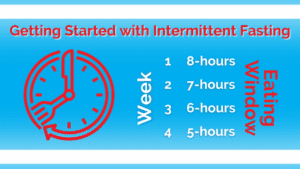We’ve identified five essential steps for starting your fasting journey. If you’re interested in learning more or want continued support and accountability to help you implement and sustain fasting in your lifestyle, Health Coach Alice Smith will be leading our next Fasting (no lunch) Small Group course from August 3 – August 23 on our app. As a premium member, you can participate in the course at no cost.
Step One: Before you start…get advice
Before you start an intermittent fasting or time-restricted feeding schedule you should talk to your doctor.
You may have medical conditions that need close monitoring. Likewise, you may be on medications that may need to be adjusted. It is important to have a strong understanding of your medical history and the medications you take prior to initiating a fasting program. Please talk to your doctor.
Step Two: Consider ditching sugars and focus on protein and healthy fats
Forget about foods that never fill you up. Many sugars and processed carbs just aren’t satiating. Before you start your fasting program you may want to consider reducing sugars and processed carbohydrates, this may make fasting much easier.
Focus on getting meals that are rich in protein and healthy fats. Eat all types of meat like beef, fish, chicken, eggs, lamb and seafood. Yogurt & Cheeses are also nutritious and filling. Fill up on low-sugar fruit like olives, peppers, cucumbers, avocado, and eat as many green leafy vegetables as you please. This approach will help you get better adapted to fat metabolism and may make fasting easier to adopt.
Step Three: Start slow

You don’t have to start right away into a multi-day fast. You can consider starting slowly. Consider a liberal 8 hour eating window on your first day to see how it feels. Eat as you please during your 8 hour time frame and see how your body and appetite feel during the remaining hours of the day.
Slowly narrow your eating window. As you feel more comfortable assessing your hunger, and understanding the nature of hunger pangs, you can slowly decrease your daily feeding window. Consider decreasing by one hour a week, until you reach a 4 hour window.
Step Four: Hunger Pangs
If you haven’t made adjustments to your diet beforehand to include more satiating foods filled with protein, healthy fat and fiber, you may notice hunger pangs, right away.
Drink water, tea, coffee, or re-assess your hunger. If you are experiencing hunger pangs, consider drinking some hot tea, coffee, water or seltzer. This may fill your stomach up and give you enough time to realize that maybe you really aren’t as hungry as you initially thought.
Step Five: Have fun and remember to eat.
Remember, that this should feel good. This should be a good experience, focused on self-learning, as your body becomes adapted to fat metabolism. It should not be excessively difficult. If you don’t feel well consider stopping your fasting regimen and talk to your doctor.
Time-restricted feeding and intermittent fasting are great ways to limit snacking. They are best done when you are eating satiating foods during your eating windows. Have fun and tell us about your experience.
Use our app to get started now at your own pace but if you need comprehensive medical care, reach out to our office.





